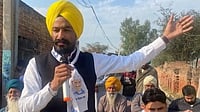When the Centre pushed through three contentious farm laws in September 2020, peasants of Punjab were the first to erupt in anger. The dissent soon morphed into what would become one of India’s longest-running mass stirs in recent times. Here’s how the agitation was launched and continues…
The Beginning
The first sites of protest were the intersections of villages and towns in Punjab and Haryana, where farmers began picketing against the new laws. Railways tracks, train stations, toll plazas and fuel depots on the highways soon became the major protest sites. Around 100 places were turned to ‘pucca dharna’ sites within three months, before the farmers marched to the borders of Delhi on November 26, 2020. Soon Singhu, Tikri and Ghazipur became the ground zero of the protests, where they continue. “Many of the protest sites have become the second home for families. Entire families of farmers, including women, children and the elderly, are involved in the movement,” says Balbir Singh Rajewal, a leader of the Samyukt Kisan Morcha (SKM) and president of the Bharatiya Kisan Union (Rajewal faction).

Supply Lines
Convoys of tractor-trolleys criss-crossed the borders of Delhi, Punjab and Haryana, carrying essential items to the protest sites— food stuff, vegetables, gas cylinders etc. Hundreds of pots and other utensils for cooking and serving were brought from village gurudwaras.
As the agitation grew in days, washing machines were brought in to help the families in the protest sites. Sleeping halls were erected, air conditioners and western washrooms installed. Medical camps and classes for students were run by volunteers all through the agitation. Punjabi singers, actors and stand-up comedians performed at public meetings, keeping the protesters entertained. Kabaddi matches were also organised. The cavalry of Nihang Jathas from Anandpur Sahib enthused farmers with their physical feats. A Kisan Library was set up on the Singhu border.

Countering Propaganda
Dubbed Khalistanis and anti-nationals by a section of a media and right-wing trolls, the farmers hit back with Trolley Times, a newsletter conceptualised and brought out by the youth among the protesters. The agitation also launched a social media blitz with their @tractor2twitter, Facebook and Instagram handles to tell their version of the story, says Navkiran Natt, one of the four editors of Trolley Times. To keep morale of the farmers high during the long-drawn agitation, there was regular screening of inspirational films like Punjab 1984, Char Sahibzade, Shaheed Bhagat Singh and Pipli Live in a mini theatre named ‘Trolley Talkies’ at Singhu.
ALSO READ: 'Hum Dekhenge': Times When India Protested
Popular Punjabi singers like Diljit Dosanjh, Guru Randhawa, Gippy Grewal, Harbhajan Mann, Babbu Mann and Kanwar Grewal performed at the protest sites and posted on their social media pages in support of the farmers.

Her Story, Their Story
Jaagir Kaur of the Bharatiya Kisan Union Ugrahan (Ekta)’s women’s wing has gone to her village in Mansa district of Punjab only three times since arriving at Tikri protest site in November 2020. From serving meals to hundreds of farmers and selling BKU flags and banner, she has been a loyal foot soldier of the agitation like countless others. BKU general secretary Sukhdev Singh Kokri Kalan says that it is because of the likes of Kaur that in a year, the union have sold flags, banners and stickers worth about Rs 40 lakh. A Ludhiana-based industrialist has provided ration, warm clothes, slippers and medicines to help the agitating farmers.

Money Matters
Agitation leaders say that funding of the movement has been very accountable and transparent. Apart from Punjabi NRIs settled in Canada, the UK, the USA and Australia, farmer families from every village of Punjab have also donated money for the movement.
Says Kalan, “Twice a year, during Kharif and Rabi crops, many resident farmers of 13,000 villages and ‘dhanis’ of Punjab have given voluntarily grants since the movement started. The funds are collected through proper receipts. Expenditure is also done under the supervision of a special committee of the movement. Every month, details of deposits, grants and expenditure are pasted in the form of posters in village chaupals and main squares”.
(This appeared in the print edition as "Anatomy of Farmers Movement")
ALSO READ


























